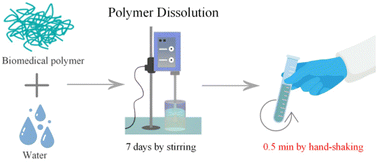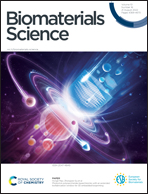A coordination strategy to achieve instant dissolution of a biomedical polymer in water via manual shaking†
Abstract
Organic polymers with condensed long chains show slow dissolution kinetics in solvents, particularly in water, which has significantly hindered their potential applications where their instant dissolution without any assistance of a stirring machine, etc. is required. Herein, we put forward a strategy of rapid dissolution of chain-like polymers by coordinating with small molecular additives, using a thermogellable amphiphilic copolymer and CaCl2 for demonstration. We synthesized a block copolymer of poly(ethylene glycol) (PEG) and poly(lactide-co-glycolide) (PLGA) and prepared its powder after coordinating with calcium ions. Compared to the virgin copolymer, the composite was dissolved in water at a rate of over 104 fold, and simple manual shaking for half a minute could form its aqueous solution. Chelation using sodium citrate was further suggested to alleviate the possible biocompatibility problem caused by calcium ions. Finally, the potential application of the thermogels prepared by the rapid dissolution strategy for an instant use in hospitals was demonstrated in an ex vivo porcine model of a fluid cushion for endoscopic submucosal dissection. The mechanism was discussed, and the critical factor comes from the coordination between calcium ions and the PEG block in the copolymer. The strategy to introduce a solvable small molecular additive coordinated with the polymer chain at the molecular level is helpful for accelerating the dissolution of organic polymers in a solvent to a large extent.



 Please wait while we load your content...
Please wait while we load your content...